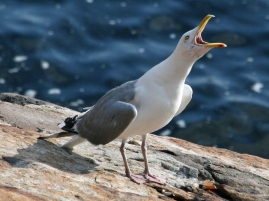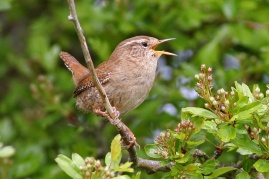Sitting on a wood piling at a marina, a motionless Herring Gull stared out over the boats. Humans strolled by on one side of the gull, boats purred by on the other.
High overhead, two other gulls appeared, flying lazily toward the ocean. Without looking up at all as far as I could tell, the Herring Gull squatted slightly, thrust its neck downwards and its head upwards, and let out several very loud, prolonged squawks, then resumed his silence. The other gulls, if they noticed, didn’t show it.
I was surprised that the Herring Gull was unfazed by the people and boats moving close by but reacted loudly to the two others far above. Was he saying “Beat it”? Or “Hey, good lookin’”? Or did the other gulls have nothing to do with his alarm?

Judging partly from the gull’s hunkered position, I thought at first that I had heard the Herring Gull’s “choking call,” an emphatic defense best rendered as “No, I’m not moving!” But after more googling, I wasn’t so sure. The call could have been the familiar “long call” of gulls, a series of raucous, trumpeted yawks that assert their territory.
But gulls don’t ever really “sing.” Most of the singers among birds, the makers of trilled, often complex melodies, are closer to home. The Robins, Sparrows, Wrens, Cardinals, Mockingbirds, and other backyard birds that perch on branches and at feeders, hop on the ground, and take flight together are among the maestros. With a vocal organ, the syrinx, that divides where the windpipe forks into the lungs, song birds can produce rapid trills and even two notes at the same time.
Debbie Ackerman in The Genius of Birds (2017) describes the difference between calls and songs. Calls “are typically short, simple, succinct, and innate (like a human scream or laughter), uttered by both sexes to make their point.” Perching birds call to “warn of predators and to identify family, friends, and foes. [Males also] sing to defend their territory—to stake it out or fence it in—and to woo a mate” (141).
The Britannica adds this:
Bird song is best considered the vocalization that is used in courtship and breeding, chiefly by the male, to advertise that he is ready to mate, to attract the female and perhaps stimulate her sexually, to keep the pair together, and to inform rival males that he has established a territory from which they will be excluded. The male’s call are also part of a threat display that take the place of actual combat in repelling intruding rivals. (“Songbird”)
I’ve wondered about the connections between the modest size of such birds, their vocal skills, their perching, and their reproductive success. As a a sophisticated instrument for social communication, their songs may have made them fitter for the flying, flocking, and perching life. Today the perching birds number more than half of the 200 to 400 billion individual birds worldwide, and their 5,000 species account for more than all other bird species combined. Not bad for feathery successors of the dinosaurs.*

I’m reminded that no type of organism alive now, including ours, has come down from its start as a fixed package of parts and abilities. We living things are the history of our changing survival strategies. Gulls, insects, flowers, trees, apes, humans––we are works in progress, ongoing creations. While we are alive, we are only the current versions.
###
*Cheery little birds descended from dinosaurs! Ackerman puts her finger on some similarities:
It’s easy to catch the reptilian in birds. You can see it in their beady eyes and quick darting movements; in the pterodactyl-like wings of a rhinoceros hornbill; in a robin holding up his head in frozen alertness to catch a sound, his expressionless face remindful of a lizard’s; or in a great blue heron—the slow heavy wing beat, the snaky finesses of its neck, the hoarse squawks, are all a throwback to dinosaur lagoons. But it baffles the imagination to think that the tiny flashlike chickadee could have arisen from the big beasts of vanished ages. (45)
In addition to sources mentioned, Wikipedia, Quora, Earbirding, and Cornell University’s All About Birds have been useful sources.
